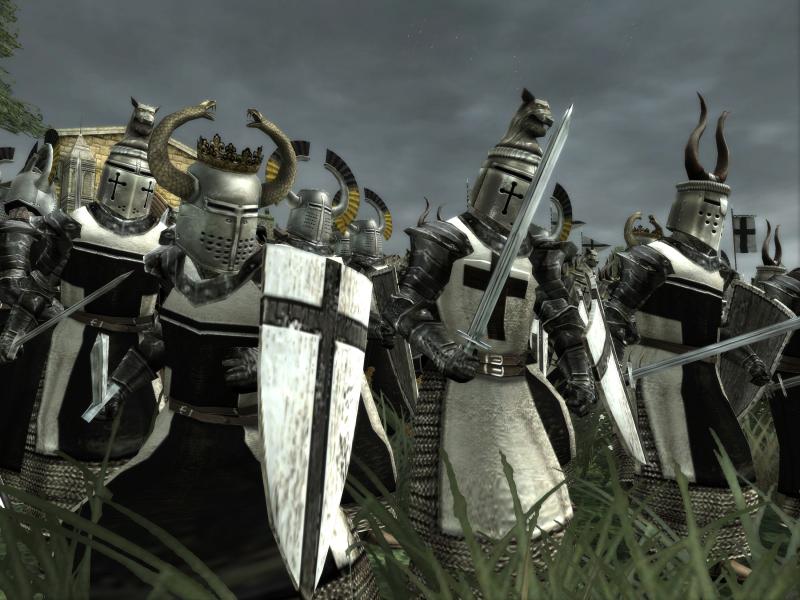
Taken from Wikipedia.org
The Order of Brothers of the German House Saint Mary in Jerusalem [1] (Official names: Latin: Ordo domus Sanctæ Mariæ Theutonicorum Hierosolymitanorum, German: Orden der Brüder vom Deutschen Haus St. Mariens in Jerusalem), or for short the Teutonic Order (Today: German Order), is a German Catholic religious order. It was formed to aid Christians on their pilgrimages to the Holy Land and to establish hospitals to care for the sick and injured. Its members have commonly been known as the Teutonic Knights, since they also served as a crusading military order during the Middle Ages. The membership was always small and whenever the need arose, volunteers or mercenaries augmented the military forces.
Origins
Formed at the end of the 12th century in Acre, in the Levant, the medieval Order played an important role in Outremer, controlling the port tolls of Acre. After Christian forces were defeated in the Middle East, the Order moved to Transylvania in 1211 to help defend Hungary against the Kipchak Turks. They were expelled by force in 1225 after allegedly attempting to place themselves under Papal instead of Hungarian sovereignty.
In 1230, following the Golden Bull of Rimini, Grand Master Hermann von Salza and Duke Konrad I of Masovia launched the Prussian Crusade, a joint invasion of Prussia to Christianise the Baltic Old Prussians. The Order then created the independent Monastic State of the Teutonic Knights in the conquered territory, and subsequently conquered Livonia. The Kings of Poland accused the Order of holding lands rightfully theirs.
The Order lost its main purpose in Europe with the Christianisation of Lithuania. The Order became involved in campaigns against its Christian neighbours, the Kingdom of Poland, the Grand Duchy of Lithuania, and the Novgorod Republic (after assimilating the Livonian Order). The Teutonic Knights had a strong economic base, hired mercenaries from throughout Europe to augment their feudal levies, and became a naval power in the Baltic Sea. In 1410, a Polish-Lithuanian army decisively defeated the Order and broke its military power at the Battle of Grunwald (Tannenberg).
In 1515, Holy Roman Emperor Maximilian I made a marriage alliance with Sigismund I of Poland-Lithuania. Thereafter the Empire did not support the Order against Poland. In 1525, Grand Master Albert of Brandenburg resigned and converted to Lutheranism, becoming Duke of Prussia a vassal of Poland. Livonia soon followed, and also the Order's holdings in Protestant areas of Germany.
The Order kept its considerable holdings in Catholic areas of Germany until 1809, when Napoleon Bonaparte ordered its dissolution and the Order lost its last secular holdings. The Order continued to exist as a charitable and ceremonial body. It was outlawed by Adolph Hitler in 1938, but re-established in 1945. Today it operates primarily with charitable aims in Central Europe.
The Knights wore white surcoats with a black cross. A cross pattée was sometimes used as their coat of arms; this image was later used for military decoration and insignia by the Kingdom of Prussia and Germany as the Iron Cross and Pour le Mérite. The motto of the Order was:"Helfen, Wehren, Heilen" ("Help, Defend, Heal")
Names
The officially used full name of the Order in German is Orden der Brüder vom Deutschen Haus St. Mariens in Jerusalem or in Latin Ordo domus Sanctæ Mariæ Theutonicorum Hierosolymitanorum (engl. "Order of the House of St. Mary of the Germans in Jerusalem"). It is commonly known in German as the Deutscher Orden (official short name, engl. "German Order"), historically also as Deutscher Ritterorden ("German Order of Knights"), Deutschherrenorden, Deutschritterorden ("Order of the German Knights") or "Die Herren im weißen Mantel" ("The masters with the white cape").
The Teutonic Knights have been known as Zakon Krzyżacki in Polish and as Kryžiuočių Ordinas in Lithuanian, "Vācu Ordenis" in Latvian, "Saksa Ordu" or, simply, "Ordu" ("The Order") in Estonian, as well as various names in other languages.
Universal leadership
[edit] Generalkapitel
The Generalkapitel (general chapter) was the collection of all the priests, knights and halfbrothers (German: "Halbbrüder"). Because of the logistical problems to assemble the members, who were spread over large distances, only deputations of the Balleien and Kommenden gathered to form the Generalkapitel. The Generalkapitel was designed to meet once in a year, but the conventions usually were limited to the election of a new Hochmeister. The decisions of the Generalkapitel had a binding effect on the Großgebietigers of the order.
[edit] Hochmeister
The Hochmeister (grand master) was the highest officer of the order. Until 1525, he was elected by the Generalkapitel. He had the rank of an ecclesiastic imperial state leader and was sovereign prince of Prussia until 1466. Despite this high formal position, practically, he only was a kind of first among equals.
[edit] Großgebietiger
The Großgebietiger were high officers with competence on the whole order, appointed by the Hochmeister. There were five offices.
- The Großkomtur (Magnus Commendator), the deputy of the Hochmeister
- The Treßler, the treasurer
- The Spitler (Summus Hospitalarius), responsible for all hospital affairs
- The Trapier, responsible for dressing and armament
- The Marschall (Summus Marescalcus), the chief of military affairs
[edit] National leadership
[edit] Landmeister
The order was divided in three national chapters, Prussia, Livland and the territory of the Holy Roman Empire. The highest officer of each chapter was the Landmeister (country master). They were elected by the regional chapters. In the beginning, they were only substitutes of the Hochmaster but were able to create a power of their own. Within their territory, the Hochmeister could not decide against their will. In the end of the rule over Prussia, factual, the Hochmeister only was Landmeister of Prussia. There were three Landmeister
- The Landmeister in Livland, the successor of the Herrenmeister (lords master) of the former Livonian Brothers of the Sword
- The Landmeister of Prussia, since 1309 united with the office of the Hochmeister, who was situated in Prussia since then.
- The Deutschmeister, the Landsmeister of the Holy Empire. When Prussia and Livland were lost, the Deutschmeister also became Hochmeister.